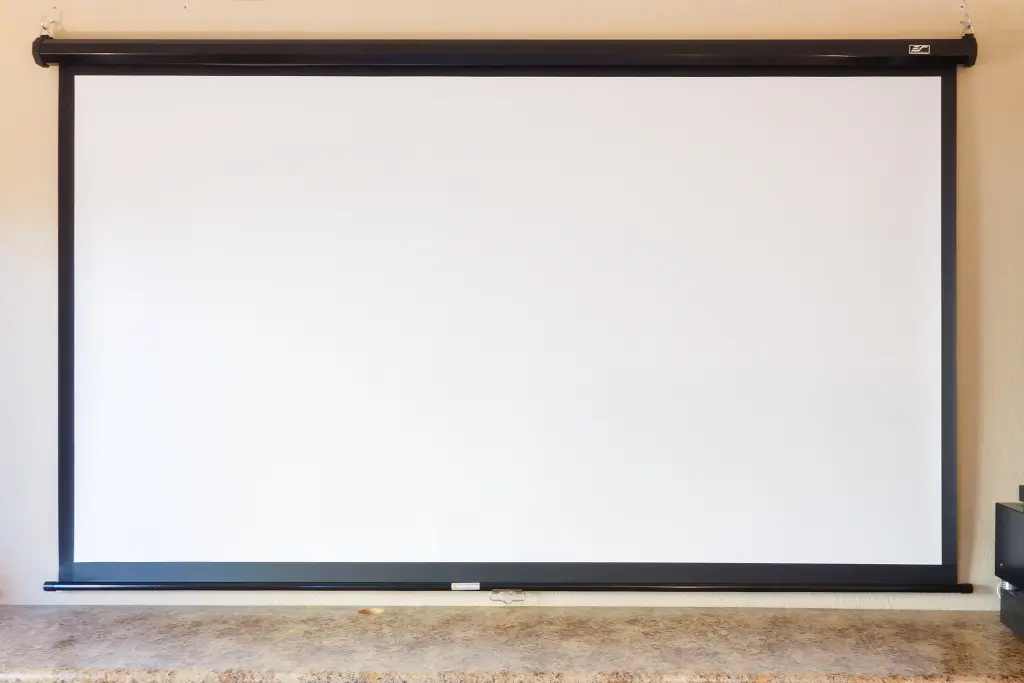Navigating the used projector screens can seem daunting. Yet, with the right knowledge, you can snag a great deal without compromising on quality. Whether it’s for home entertainment or professional presentations, a screen for projector setups plays a crucial role in viewing quality.
Understanding Projector Screen Basics
It’s crucial to differentiate between the types of projector screens available. Electric projector screens are among the favorites for their convenience and advanced features. However, manual and fixed-frame screens also have their place, depending on the usage scenario. The material of the screen notably affects the image quality, with options ranging from matte white to high-contrast gray screens, each serving different lighting environments and projector types. This fundamental knowledge serves as the foundation for choosing the best used projector screen for your specific needs.
Advantages of Electric Projector Screens
Electric projector screens elevate the convenience and aesthetic of any space they’re installed in. Their motorized function not only makes them easy to use but also helps preserve the screen’s longevity by ensuring that it retracts smoothly and without unnecessary handling. This type of screen is ideal for environments where presentations are frequent but space needs to remain versatile. The seamless integration of technology into professional or recreational spaces underscores a commitment to quality and functionality.
Key Features to Look For
When you’re browsing for an electric projector screen, check for:
- Screen Material: High-quality material will ensure clear and vibrant images.
- Size and Aspect Ratio: Match the screen size and ratio to your projector and room requirements.
- Condition: Look for signs of wear or damage, especially in the mechanical parts if it’s motorized.
Where to Buy
The Internet has made finding a used projector screen more accessible than ever. Websites specializing in AV equipment often feature a wide range of options, from high-end electric screens to more budget-friendly manual options. These platforms usually offer extensive product descriptions, reviews, and even buyer protection to ensure satisfaction. However, local AV stores or second-hand shops can also be treasure troves of good finds, often allowing for in-person inspection.
Inspection Tips
Inspecting a used projector screen, especially an electric projector screen, requires attention to detail. The screen surface should be free of any significant marks or scratches, as these can distort the image. Testing the retraction mechanism is crucial to ensure smooth operation. A thorough check might also include listening for any irregular sounds from the motor, indicating potential issues. Asking for a demonstration or even a video if buying online can provide additional assurance before the purchase.
Benefits of Purchasing Used
The primary advantage of opting for a used projector screen is the substantial savings compared to buying a new one. These savings can be redirected to other areas of your setup or saved for future upgrades. Additionally, buying supports the principle of recycling, contributing to a more sustainable approach to consumer electronics. With thorough research and careful selection, buyers can find screens that are virtually indistinguishable from new units.
Cost Considerations
While the initial price tag is a significant factor, potential buyers should also factor in any additional expenses. Depending on the screen’s condition, there might be costs related to cleaning, minor repairs, or even replacement of parts like the motor in electric models. However, these costs can often be mitigated by the overall savings and by choosing a product with a transparent condition report and a good warranty.
Maximizing Longevity: Caring for Your Used Projector Screen
Maintaining your used projector screen in prime condition extends its life and ensures you enjoy the best viewing experience for years to come. Whether you’ve chosen an electric model or a more traditional manual screen, certain practices can help protect your investment from wear, tear, and environmental factors.
Regular Cleaning
Dust and dirt can accumulate on the screen surface over time, affecting image clarity. Regular cleaning with a soft, damp cloth can keep the surface pristine. It’s essential, however, to avoid harsh chemicals that might damage the screen material. For electric screens, ensuring the mechanics are dust-free adds to the device’s smooth operation.
Proper Operation
For electric projector screens, utilizing the control mechanisms correctly plays a significant role in maintaining the screen’s integrity. Avoid forcing the screen to retract or extend faster than its motor is designed to handle. For manual screens, equally important is gentle handling to prevent any sudden jerks or pulls that might tear the screen or damage the rolling mechanism.
Environmental Considerations
Positioning your used projector screen in a suitable environment is crucial. Avoid direct sunlight, which can fade the screen material over time. Humidity and extreme temperatures can also affect the screen’s materials and mechanical components, so strive for a stable and controlled environment whenever possible.
Storing When Not in Use
If your screen won’t be in use for an extended period, proper storage can significantly prolong its life. For retractable models, ensure the screen is fully retracted to prevent dust accumulation and potential damage. For fixed screens, covering the screen with a breathable fabric can protect it from dust and sunlight.
Conclusion
Choosing the right used projector screen involves careful consideration and some savvy shopping. By following these tips, you’ll make a well-informed purchase that ensures value and quality.
For a wide range of options including front projector screens, electric projector screens, and more, visit GearSource, your reliable source for quality used audio and visual equipment. Their selection is vast and includes detailed product conditions, ensuring you make the best purchase for your needs.



